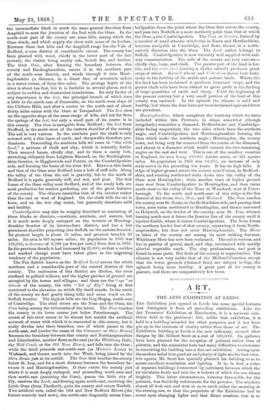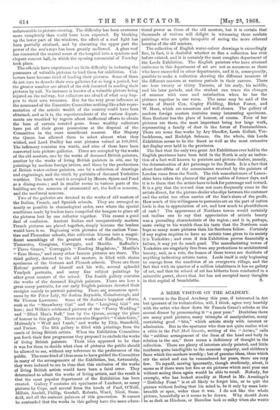ART.
THE ARTS EXHIBITION AT LEEDS.
THE Exhibition just opened at Leeds has some special features that distinguish it from all preceding exhibitions. Like the Art Treasures' Exhibition at Manchester, it is a national exhi- bition held in the provinces; but, unlike that exhibition, it is held in a building intended for other purposes, and it has been got up in the interests of charity rather than those of art. The Exhibition building at Leeds is the new infirmary, erected after designs by Mr. Gilbert Scott at a cost of 100,0001. Its galleries have been planned for the reception of patients rather than of pictures, and the committee have had many difficulties to overcome in converting the building into a fine-art exhibition. Acting upon the modern belief that good air and plenty of light are the best cura- tive agents, Mr. Scott has specially planned his building so as to secure excellent ventilation and lighting. It is, in fact, a series of separate buildings (connected by corridors) between which the air circulates freely and into the windows of which the sun shines brightly. This latter circumstance, however favourable for the patients, was decidedly unfortunate for the pictures. The windows almost all look east and west so as to catch either the morning or the evening sun, so that the projectors of the Exhibition had to count upon changing lights and that direct sunshine that is so unfavourable to picture-viewing. The difficulty has been overcome more completely than could have been expected. By blocking up the lower part of the windows, the effect of a roof light has been partially attained, and by obscuring the upper part the power of the sun's rays has been greatly mellowed. A. glass roof has converted the central court of the hospital into a spacious and elegant concert hall, in which the opening ceremonial of Tuesday took place.
The officials have experienced no little difficulty in inducing the possessors of valuable pictures to lend them for exhibition. Col- lectors have become tired of lending their pictures. Some of them do not care to denude their own galleries for so long a period, but the greater number are afraid of the risk incurred in sending their pictures by rail. No instance is knoWn of a valuable picture being injured on the railway, but collectors are afraid of what nay hap- pen to their own treasures. But for the very great influence at the command of the Executive Committee nothing like a fair repre- sentation of the artistic wealth of the country could have been obtained, and as it is, the superintendents of the various depart- ments are troubled by regrets about ineffectual efforts to obtain the loan of certain coveted gems. Some wealthy collectors have put all their great possessions at the disposal of the Committee in the most munificent manner. Her Majesty the Queen has allowed them to select almost what they wished, and Lord Dudley has sent pictures valued at 100,0001. The infirmary contains ten wards, and nine of these have been converted into picture galleries. Three are occupied by the works of the old masters, one by the works of deceased British painters, another by the works of living British painters in oils, one by paintings by modern foreign:artists, and three by the productions of British water-colour painters, one by a collection of drawings and engravings, and the ninth by portraits of deceased Yorkshire worthies. The tenth ward is occupied by Messrs. Spiers and Pond as a dining-room ; and in smaller rooms in various parts of the building are the museum of ornamental art, the Indian museum, and the mediaeval museum.
Two of the galleries are devoted to the works of old masters of the Italian, French, and Spanish schools. They are arranged as nearly as possible in chronological order, save where the special conditions made by lenders have compelled the hangers to place all the pictures lent by one collector together. This causes a good deal of confusion. Ancient Italian and comparatively modern French pictures are placed together, simply because the lenders would have it so. Beginning with pictures of the earliest Vene- tian and Florentine schools, this collection blooms into a magni- ficent assemblage of the greatest works of Raffaelle, Titian, Tintoretto, Giorgione, Correggio, and Murillo. Raffaelle's " Three Graces," Correggio's " Reading Magdalene," Murillo's " Ecce Homo," and many other famous pictures are there. The third gallery, devoted to the old masters, is filled with choice specimens of the German and Flemish schools. There are there Ruben' portraits of himself and his wife, several splendid Vandyck portraits, and many fine subject paintings by other great masters of the school. The fourth gallery contains the works of the deceased English painters. There are here a great many portraits, for our early English painters devoted their energies mainly to portrait painting. There are numerous speci- mens by Sir Peter Lely, Sir Joshua Reynolds, Gainsborough, and Sir Thomas Lawrence. Some of Sir Joshua's happiest efforts, such as the " Strawberry Girl" and the " Laughing Girl " are here ; and Wilkie's celebrated pictures of the "Penny Wedding" and "Blind Man's Buff," lent by the Queen, occupy the place of honour in this gallery. There are also Hogarth's " Calais Gate," Mulre.ady's " Wolf and Lamb," and works by Etty, Stanfield, and Turner. The fifth gallery is filled with paintings from the easels of living British artists. When the Exhibition Committee put forth their first programme they proposed to exclude the works of living British painters. Their idea appeared to be that it was for them to decide what class of pictures the public should be allowed to see, without any reference to the preferences of the public. The same kind of ideas seem to have guided the Committee in many of the arrangements of the Exhibition, but, fortunately, they were induced to see in time that this exclusion of the works of living British artists would have been a fatal error. They determined to admit the works of living artists, and the result is that the most popular department of the Exhibition has been created. Gallery F contains six specimens of Landseer, as many pictures by Cope, and several from the hands of Feed, O'Neill,
Ansdell, Phillip, Goodall, Roberts, Ward, Nicol, Stan- field, and all the eminent painters of this generation. It cannot be contended that the works in this gallery have the same educa-
tional power as those of the old masters, but it is certain that thousands of visitors will delight in witnessing these modem paintings who are quite incapable of seeing the more ethereal beauties of the old masters.
The collection of English water-colour drawings is exceedingly fine, in fact, it is doubtful whether so fine a collection has ever before existed, and it is certainly the most complete department of the Leeds Exhibition. The English painters who have attained eminence in this department of art are not so numerous as those who have succeeded in other departments, and it is, consequently, possible to make a collection showing the different manners of the different masters at various periods in their careers. There are here twenty or thirty Turners, of his early, his middle, and his later periods, and the student can trace the changes of manner with ease and satisfaction when he has the pictures together in one room. The same may be said of the works of David Cox, Copley Fielding, Birket Foster, and W. Hunt, which are numerous and well chosen. The gallery of modern foreign masters contains many interesting specimens. Rosa Bonheur has the place of honour, of course. Four of her pictures are there, the most important being her large work, representing a family of deer in the forest of Fontainebleau. There are some fine works by Ary Shceffer, Louis Gollait, Ver- beckhoven, and Rudolph Sehman. On the whole, this Leeds Exhibition seems to be the finest as well as the most extensive Art display ever held in the provinces.
The fact that the only two great Art Exhibitions ever held in the English provinces have been held in the North is only an indica- tion of a fact well known to painters and picture-dealers, namely, the determination of Art patronage to the North. It is a fact that about four-fifths of the commissions received by the painters of London come from the North. The rich manufacturers of Lanca- shire have taken the places of the great nobles of former days, and it is to them that the artists have to look for patronage and reward. It is a pity that the reward does not more frequently come to the artists direct, for the picture-dealer who slips between the customer and the artist too often carries off the lion's share of the profit. How much of this willingness to patronize art on the part of cotton lords is due to appreciation of art, and how much to plentifulness of cash ? The appearance of Northern towns would certainly not incline one to say that appreciation of artistic beauty was a prevailing characteristic of the region ; and it is, perhaps, more owing to his wealth than his taste that the Northern man buys so many more pictures than his Southern fellow. Certainly if any region requires to have an artistic tone given to its society it is Yorkshire ; and even if this Exhibition proves financially a failure, it may yet do much good. The manufacturing towns of Yorkshire are singularly free from any pretentions to architectural beauty, and, as a rule, the homes of those towns are destitute of anything indicating artistic tastes. Leeds itself is only beginning to emerge from the condition of an overgrown village, and the fact that with its quarter of a million inhabitants it has no gallery of art, and that its school of art has hitherto been conducted in a miserable garret, shows that Art has not occupied many thoughts



































 Previous page
Previous page